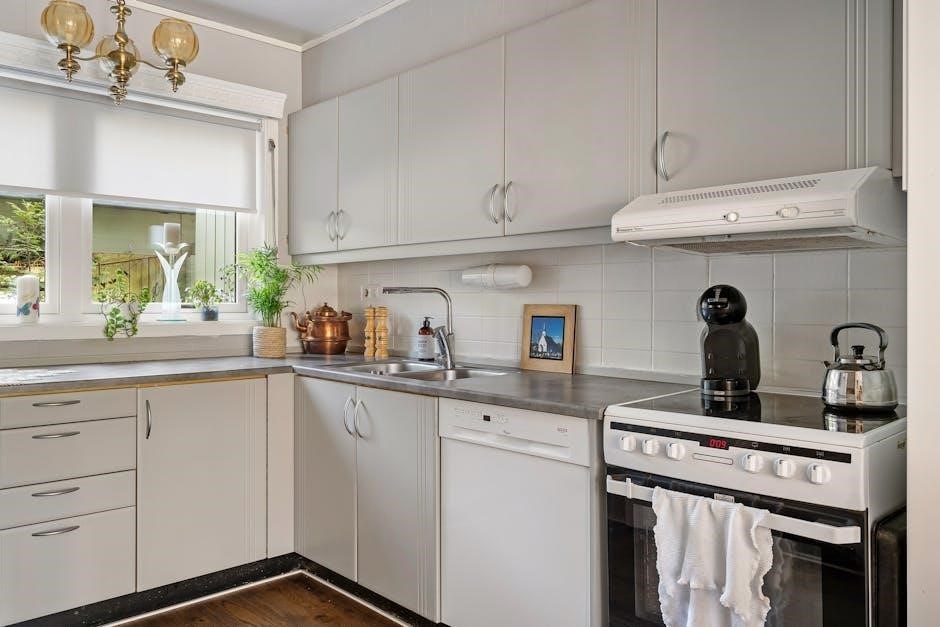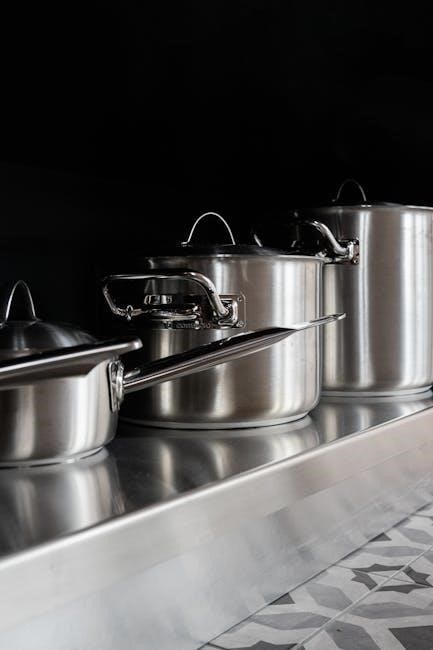Safety Precautions and Important Safeguards
Always read the manual before use. Never leave the cooker unattended while in operation. Keep children away from the appliance. Regularly inspect seals and valves for damage. Avoid touching hot surfaces and use oven mitts for handling. Ensure the pressure valve is clean and free from obstructions. Follow recommended cooking times and pressures to prevent overcooking or accidents. Store the cooker in a dry place when not in use. Unplug the unit before cleaning or maintenance. Never operate the cooker with damaged cords or malfunctioning parts. Always allow the cooker to cool down naturally before opening the lid.
- Do not operate while unattended.
- Keep children and pets away.
- Regularly inspect seals and gaskets.
- Avoid overfilling the cooker.
- Use oven mitts for handling hot components.
1.1 Essential Safety Tips for First-Time Users
Before first use, carefully read the manual to understand all functions and safety features. Familiarize yourself with the pressure valve, safety lock, and steam release mechanism. Always ensure the lid is securely locked before cooking. Never force-open the cooker while it’s under pressure. Keep the cooker on a stable, heat-resistant surface away from flammable materials. Avoid overfilling the pot, as this can lead to clogging or unsafe conditions. Always use the recommended accessories and follow the manufacturer’s guidelines for ingredient quantities and cooking times.
- Read the manual thoroughly before first use.
- Understand the pressure valve and safety lock.
- Never force-open the cooker under pressure.
- Keep the cooker on a stable surface.
- Avoid overfilling the pot.
1.2 Understanding the Pressure Valve and Safety Lock
The pressure valve regulates steam release, ensuring safe operation. The safety lock prevents lid opening while pressure is high. Regularly clean the valve to avoid blockages. Always check the lock’s proper alignment before cooking. These features prevent accidents and ensure efficient pressure control during cooking cycles. Proper maintenance of these components is crucial for long-term functionality and safety.
- The pressure valve controls steam release safely.
- The safety lock secures the lid during operation.
- Regular cleaning prevents valve blockages.
- Ensure the lock is aligned before cooking.
Getting to Know Your Cooks Essentials Pressure Cooker
Familiarize yourself with the cooker’s features, including its size, digital control panel, and preset functions. Models like 99740 and K41143/EPC-678 offer varying capacities and advanced settings for versatile cooking.
2.1 Key Features and Components Overview
Your Cooks Essentials Pressure Cooker features a digital control panel, preset cooking functions, and a removable stainless steel pot. Key components include the lid, pressure valve, safety lock, and sealing ring. The cooker also includes a steam basket and measuring cup for added convenience. The control panel offers options for sautéing, browning, and delay cooking, while the pressure valve ensures safe and efficient cooking.
- Removable stainless steel pot for easy cleaning.
- Digital control panel with preset functions.
- Pressure valve and safety lock for secure operation.
- Steam basket and measuring cup included.
- BROWN mode for sautéing and browning.
- Delay start function for convenient meal planning.
2.2 Differences Between Models (e;g., 99740, K41143/EPC-678)
The Cooks Essentials 99740 is a 4.2-quart electric pressure cooker, while the K41143/EPC-678 is a 6-quart digital model. The 99740 offers basic preset functions, whereas the K41143/EPC-678 includes advanced features like delay start and the brown function. The 6-quart model also has a larger capacity, making it more versatile for bigger families or meal prepping.
- 99740: 4.2-quart capacity, basic functions.
- K41143/EPC-678: 6-quart, digital controls, delay start, and brown function.
- Larger model ideal for bigger households or batch cooking.

Initial Setup and Preparation
Unbox and wash all parts with soapy water. Dry thoroughly before assembly. Ensure the pot, lid, and seals are securely fitted. Plug in the cooker and familiarize yourself with the control panel. Perform a test run with water to confirm proper function.
- Wash and dry all components before first use.
- Ensure all parts are securely assembled.
- Run a test cycle with water to verify operation.
3.1 Unboxing and Cleaning Before First Use
Carefully unbox your Cooks Essentials pressure cooker and inspect for damage. Wash the removable pot, lid, and seals with warm soapy water. Rinse thoroughly and dry with a soft cloth. Clean the exterior with a damp sponge. Ensure all parts are free from packaging residue. Allow components to air dry completely before assembly; This ensures safe and hygienic first use.
- Inspect all parts for damage or defects.
- Wash removable components with mild soap.
- Dry thoroughly to prevent water spots.
- Wipe the exterior with a damp cloth.
3.2 Assembling the Pressure Cooker
Place the cooker on a stable surface. Align the removable pot with the base, ensuring it clicks securely. Attach the lid by matching the guide marks. Install the pressure valve and safety lock according to the manual. Ensure all seals are properly seated. Tighten any connectors firmly but avoid over-tightening. Double-check that all parts are aligned and secure before use. Verify the pressure valve function by gently pressing it.
- Align and secure the pot to the base unit.
- Attach the lid and ensure proper alignment.
- Install the pressure valve and safety lock.
- Check all seals for correct positioning.
Operating the Pressure Cooker
Plug in the cooker and ensure the lid is securely locked. Use the control panel to select cooking modes or preset functions. Enter desired time and pressure settings. Start the cooker and allow it to build pressure naturally. Monitor the cooking process through the progress indicators. Let the pressure release naturally or quick-release as needed.
- Plug in and secure the lid properly.
- Select mode and set time/pressure via control panel.
- Allow pressure to build and monitor progress.
- Release pressure naturally or manually as required.
4.1 Step-by-Step Guide to Cooking Modes
Plug in the cooker, secure the lid, and select the desired mode using the control panel. Choose from preset options like “Meat/Stew,” “Soup,” or “Poultry.” Add ingredients, close the lid, and set cooking time and pressure. Press “Start” to begin. The cooker will automatically adjust settings based on the selected mode. Do not leave the cooker unattended during operation. Allow pressure to release naturally after cooking completes.
- Select mode: Meat/Stew, Soup, Poultry, or Manual.
- Add ingredients and close the lid tightly.
- Set time and pressure, then press “Start.”
- Let pressure release naturally after cooking.
4.2 How to Prepare Ingredients for Pressure Cooking
Cut meat and vegetables into uniform sizes for even cooking. Add recommended liquids, such as broth or water, to prevent scorching. Avoid overfilling; liquids should not exceed the max line. Marinate ingredients if desired for enhanced flavor. Rinse grains and soak legumes if necessary. Place delicate foods like fish or vegetables in a steamer basket to prevent overcooking. Season ingredients before cooking for optimal taste.
- Cut ingredients into uniform sizes.
- Add liquids as per recipe guidelines.
- Marinate for extra flavor if desired.
- Rinse grains and soak legumes.
- Use a steamer basket for delicate foods.
4.3 Using the Control Panel and Preset Functions
The control panel offers easy navigation for selecting cooking modes. Use preset functions like “Sauté,” “Soup,” or “Rice” for convenient cooking. Adjust timers and pressures manually for customized recipes. Press “Start” to begin cooking. The display shows progress and remaining time. Use the “Cancel” button to pause or reset settings. Ensure all buttons are pressed firmly for proper activation. Refer to the preset chart for recommended settings.
- Select modes like “Manual,” ” Delay Start,” or “Keep Warm.”
- Use “+/-” buttons to adjust cooking time and pressure.
- Preset functions simplify cooking for specific dishes.
- Monitor progress through the digital display.
- Refer to the preset chart for optimal results.
Common Cooking Functions and Techniques
Explore versatile cooking modes like sauté, pressure cook, and slow cook. Achieve perfect results with preset functions for rice, soup, and meat. Brown ingredients for enhanced flavor before cooking. Use the timer for delayed cooking convenience. Experiment with various pressures and times for different textures. Preserve nutrients with steam cooking. Discover endless possibilities for healthy, delicious meals.
- Sauté for browning and flavor enhancement.
- Pressure Cook for quick meal prep.
- Slow Cook for tender dishes.
- Preset Functions for effortless cooking.
- Steam Cooking for nutrient retention.
5.1 Sautéing and Browning with the Brown Function
The Brown function allows you to sear and sauté ingredients directly in the cooker, enhancing flavors before pressure cooking. Add oil and cook on medium heat, stirring occasionally, until ingredients are caramelized. This step adds depth to dishes like stews and roasts. Clean the pot thoroughly after browning to prevent residue buildup and ensure optimal performance.
- Add oil and heat before searing.
- Stir ingredients for even browning.
- Clean the pot post-browning.
- Prevents residue buildup.
- Enhances meal flavors and textures.
5.2 Pressure Cooking Times for Popular Foods
Optimize cooking times for popular foods using your pressure cooker. Chicken breasts cook in 8-10 minutes, while beef stew meat takes 20-25 minutes. Rice cooks in 4-6 minutes, and lentils in 8-10 minutes. Root vegetables like potatoes and carrots require 5-7 minutes, while green beans take 2-3 minutes. Adjust times based on portion size and desired tenderness for perfect results.
- Chicken breasts: 8-10 minutes.
- Beef stew meat: 20-25 minutes.
- Rice: 4-6 minutes.
- Lentils: 8-10 minutes.
- Potatoes: 5-7 minutes.
- Green beans: 2-3 minutes.

Advanced Features and Custom Settings
Customize your cooking experience with advanced features. Program specific times and pressures for personalized recipes. Use the delay start function for convenient meal preparation. Explore preset settings for enhanced versatility in cooking various dishes.
- Custom cooking times and pressures.
- Delay start for scheduled meals.
- Preset functions for easy operation.
6.1 Programming Custom Cooking Times and Pressures
Customize your cooking experience by setting specific times and pressures for personalized recipes. Use the control panel to input desired settings, ensuring optimal results for various ingredients. The cooker allows you to adjust both time and pressure levels, providing flexibility for different cooking needs. Refer to the manual for detailed instructions on programming custom settings effectively.
- Press the “Manual” or “Custom” button.
- Use the “+” or “-” buttons to adjust time and pressure.
- Confirm settings with the “Start” button.
6.2 Using the Delay Start Function
The Delay Start function allows you to schedule cooking up to 24 hours in advance. Press the “Delay Start” button, use the “+” or “-” buttons to set the desired cooking time, and confirm with “Start.” This feature is ideal for preparing meals ahead of time. Ensure ingredients are ready and placed in the cooker before setting the delay.
- Press “Delay Start” to activate the function.
- Adjust the cooking time using the control panel.
- Confirm settings and let the cooker handle the rest.
Cleaning and Maintenance
Regularly clean the pot, lid, and seals with warm soapy water. Check the pressure valve for blockages. Dry all parts thoroughly after cleaning to prevent mold.
- Wash the removable pot and lid with mild detergent.
- Inspect and clean the pressure valve and seals.
- Ensure all parts are dry before storage.
7.1 Regular Cleaning of the Pot and Seals
Wash the pot and seals with warm, soapy water after each use. Use a soft sponge to avoid scratching. Rinse thoroughly and dry to prevent mold. Regularly inspect for food residue and clean the pressure valve. Replace worn-out seals to maintain proper function. Avoid using abrasive cleaners to prevent damage.
- Use mild detergent and warm water for cleaning.
- Inspect seals and gaskets for wear or damage.
- Avoid abrasive cleaners or scourers.
- Store parts in a dry place after cleaning.
7.2 Deep Cleaning the Pressure Cooker
For deep cleaning, remove and wash all detachable parts in warm soapy water. Use a soft brush to clean the pressure valve and vent. Wipe the exterior with a damp cloth. Soak the pot and seals in vinegar or baking soda solution to remove stubborn stains. Regularly descale if you live in hard water areas to prevent mineral buildup.
- Soak parts in vinegar or baking soda solution.
- Use a soft brush for detailed cleaning.
- Descale regularly in hard water areas.
- Avoid harsh chemicals to prevent damage.

Troubleshooting Common Issues
Common issues include lid not sealing, pressure valve malfunctions, or error codes. Check seals for damage, ensure proper alignment, and clean the valve regularly. Refer to the manual for specific error code solutions. If issues persist, contact customer support for assistance.
- Check seals and alignments for proper function.
- Clean the pressure valve and vent regularly.
- Refer to the manual for error code meanings.
8.1 Resolving Pressure Valve Malfunctions
Pressure valve issues often arise from blockages or improper alignment. Clean the valve regularly with warm water and a soft brush. Ensure the valve is free from food debris and steam can escape freely. If the valve is damaged, replace it immediately. Refer to the manual for disassembly instructions or contact customer support for assistance.
- Clean the valve with warm water and a soft brush.
- Ensure proper alignment and check for blockages.
- Replace damaged valves to maintain safety and performance.
8.2 Fixing Error Codes and Common Problems
Identify error codes by consulting the manual or online resources. Common issues include faulty sensors, clogged valves, or improper sealing. Reset the cooker by unplugging it for 30 minutes. Clean or replace damaged seals and gaskets; Ensure the lid aligns correctly and check for blockages in the steam release. Contact customer support if problems persist.
- Consult the manual for error code meanings.
- Reset the cooker by unplugging it temporarily.
- Inspect and clean or replace seals and gaskets.
- Ensure proper lid alignment and check for blockages.

Recipes and Cooking Ideas
Explore quick, healthy meal options like hearty stews, flavorful grains, and tender proteins. Use preset functions for easy-to-follow recipes tailored to your pressure cooker.
9.1 Quick and Healthy Meal Ideas
Discover simple, nutritious recipes for busy days. Try hearty chicken stir-fries, flavorful vegetable soups, or quinoa salads. Use the Brown function for crispy textures without extra fat. Prepare tender proteins and vibrant veggies in minutes. Explore one-pot meals like chili or curry for easy cleanup. Experiment with lean meats and fresh spices for wholesome, delicious dishes.
- Chicken stir-fry with mixed veggies.
- Quick lentil soup with aromatic spices.
- Crispy sautéed salmon with steamed greens.
9.2 Preset Recipes for Beginners
Start with simple, delicious meals using preset functions. Try hearty chicken and rice, flavorful chili, or tender vegetable soup. Use the Brown function for crispy textures. Explore one-touch options for perfect results. Ideal for new users, these recipes offer easy guidance for mastering pressure cooking techniques. Models like 99740 and K41143/EPC-678 include preset timers for foolproof meals.
- Chicken and rice with herbs.
- Quick chili with ground beef.
- Steamed vegetables with seasoning.
10.2 Contacting Cooks Essentials Customer Service
Warranty and Customer Support
Your Cooks Essentials pressure cooker is backed by a limited warranty. For inquiries or issues, contact customer service via phone or email. Register your product online for extended support.
- Warranty coverage varies by model.
- Contact support for repairs or replacements.
- Visit the official website for details.
